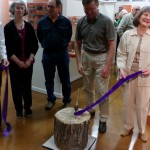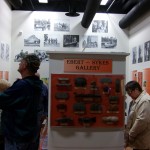Jeremy Ratliff
Reporter
A “ribbon hatcheting” was held at Merrill Historical Society’s History & Culture Center on Saturday, to celebrate the much-anticipated opening of the Native Americans Exhibit in the Ebert & Sykes Gallery. David Johnson, a member of the Merrill Historical Society Board of Directors and an expert on Native American history and culture, has spent more than a year researching and designing this permanent exhibit.
“I was pleased with the opening of the Native American exhibit at the Merrill Historical Society today,” Johnson said. “After hundreds of hours of work, it is a relief to see it finally completed. This exhibit came about through the generosity of Paul and Laura Ebert, and their daughter Sarah Sykes. They donated generously to the Historical Society building fund and donated their collection of Native American artifacts.
“Using artifacts from my collection to fill in voids, we were able to complete an exhibit that outlines Native Americans in the United States from the Paleo Period (18,000 years ago) through today,” Johnson explained.
“I was fortunate to acquire several artifacts from the former collection of Dr. Wittman, an early Native American artifact collector in Merrill, to include in this exhibit,” Johnson added. “The exhibit includes artifacts found in the Merrill and surrounding area.”
The exhibit features a chronological look at the history of Native American tribes in this country. It contains not only the Ebert collection but also many other interesting artifacts including Peace Medals given out by United States presidents as well as Clovis culture points dating back over 13,500 years. Visitors can see stone axes, mauls, celts, knives, points, and drills. Pottery, fancy beadwork, arrows and darts are also on display in this exhibit which features artifacts from across the United States, not just Wisconsin or the Merrill area.
The Society is very proud to present the Native Americans Exhibit to the community. The Merrill Historical Society’s mission is to educate the public about our heritage using the unique historical and cultural resources they collect and preserve.
Ebert family history and background
Albert and Anna Ebert were married in Merrill in 1904. Albert, a bricklayer and contractor, built the two-story red brick house which still stands at 1811 River Street, where Paul, the youngest of their seven children, was born in 1921. The Ebert family moved away from Merrill in the mid-1920s.
After Paul graduated from high school and completed a year of college he enlisted as a private in the U.S. Army Special Training program at age 21. After WWII he graduated from Oregon State University with a bachelor of science degree in electrical engineering. He met and married Oregon native Laura Anderson in 1946. They had three daughters; Sarah, Nollie, and Laura.
Paul worked for the Kohler Company for 37 years, concluding his career as the Director of Manufacturing, Vitreous China and Plastics. After his retirement in 1985 Paul and Laura moved to Presque Isle, where they continued to pursue their hobby of collecting antiques. They even had their own private museum, filled with a wide variety of furnishings, decorative objects, and logging and farming implements. Because of Laura’s Native American heritage, their acquisitions also included beautiful items from many different tribes: pottery, beadwork, peace medals, jewelry, baskets, carvings, projectile points, and other items.
Although the Ebert family doesn’t appear to have maintained ties to this community after they moved away, perhaps they retained fond memories of their years in Merrill and shared them with Paul as he grew up. It may have been those memories that eventually led Paul and Laura to choose the Merrill Historical Society as the recipient of their large Native American collection. They decided that they wanted to gift the collection to a smaller museum, where the objects wouldn’t become “lost” in a huge organization and where they would be used to inform and educate people rather than being hidden away in storage. After Paul’s death in 2008, Laura and Sarah contacted the Merrill Historical Society and offered the Eberts’ Native American collection to the Society, along with a portion of Sarah’s own Native American collection.
Laura Ebert and Sarah Sykes understood that, at the time of the donation of the collection in 2009, the Merrill Historical Society was in the planning stages for a building project and that it could be several years before it would be able to exhibit the collection. In order to help the MHS reach its fundraising goal, both Laura and Sarah made significant monetary donations to the building fund, along with their artifacts. Tragically, neither Laura nor Sarah survives to see the result of their generosity.


